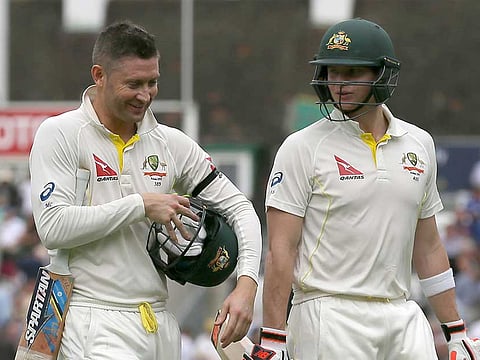Clarke gives way to an uncertain new era
Smith inherits a batting line-up with all less than 50 caps

London: The Australians were huddled together in celebration, gripping each other by the shoulders, slapping each other on the back. But their captain had broken away.
Michael Clarke was walking across the outfield, towards the northern end of the ground, where most of the Australian fans had gathered in their dark green shirts and bright yellow caps. As he approached, they rose to their feet. The ripple of applause swelled to a cacophony. Grown men started shouting. “Great career, mate!” “Well done, captain!” “Give us a smile!”
Clarke smiled. Had he gone over to salute the fans, or had he gone over so they could salute him? Probably a bit of both. Either way, Clarke looked utterly at ease: a man apart, in more senses than one. For the past four years, whenever you looked at the Australian cricket team, you knew which one was the captain.
Even if you had never watched cricket before. The broad shoulders, the flinty expression, the effortless poise, the purposeful stride: Clarke exuded leadership. If you had to pick out the next Australian captain from the cluster of players hanging around near the boundary waiting for Clarke to rejoin them, you would probably have picked all of them ahead of Steve Smith.
Smith’s manner away from the crease is very similar to his manner at it: fidgety, a little awkward, full of jerky head movements and the occasional broad smile.
When Australia are in the field, Clarke moves like a captain. After every delivery, he takes a few steps forward from second slip, ostentatiously surveying the field, applauding the bowlers and fielders, always at the heart of the action, even when no action is actually taking place. Smith, meanwhile, clasps his hands behind his back at third slip or cover point, wiggles his foot around in the air a little, speaks when he is spoken to.
Smith has always known his place. When he was struggling to convert half-centuries into centuries, it was Clarke to whom he turned for advice. “Michael has been a great captain to play under these last two years and I’ve certainly learnt a lot off him,” he said after collecting his Man-of-the-Match award at The Oval.
But Clarke has gone now. The man apart has become the man departed. This is Smith’s team now, and in many respects the passing of the baton occurred some months ago. The runs that Clarke used to score in such unfathomable numbers are now being scored by Smith. It is Smith rather than Clarke who is now the heartbeat of the dressing room: respected and liked almost universally, something Clarke has not been able to claim for about two years.
So the question is this: what exactly will Smith’s Australia look like? Clarke adored the spotlight, thrived under pressure, faced his critics head-on. Smith is more introverted. The early signs from the series against India last winter were that Smith will be a little more cautious and a little less tactically astute than his predecessor.
But then, he will be inheriting one of the weakest Australian batting line-ups for many years. Clarke and Chris Rogers will probably be replaced by two of Cameron Bancroft, Joe Burns and Usman Khawaja, meaning that for the first time since the Packer era Australia will not have a single batsman with 50 Test caps to his name.
Clarke, in his final press conference before retirement, urged Australia not to place all its faith in youth. “I would still like to see some of the old heads stick around. I don’t know if that’s going to be the case.”
This, really, encapsulates Smith’s biggest problem. Not the lack of experience in the side, but Clarke’s predilection for sticking his oar in. Clarke is not the sort to disappear quietly into the night: he will remain a grandee of Australian cricket, commentating for Channel Nine, writing newspaper columns, making his view known.
The next time Smith leads his team out in Australia, against New Zealand at Brisbane in November, Clarke will most likely be in the commentary box, telling the viewers where Smith is going wrong, pointing out how he would have done it differently. There was a moment when the ticker-tape was flying and the fireworks were popping and England were jumping up and down, trying not to get champagne on Moeen Ali.
Meanwhile, the Australian team were trudging back towards to the Oval pavilion, pining for their hotel rooms. As he climbed the steps, Smith paused and took a lingering look back at the celebrations, drinking in the scene. And at that point, it is hard to know whether he felt more embittered or emboldened.
— The Telegraph Group Limited, 2015
Sign up for the Daily Briefing
Get the latest news and updates straight to your inbox



